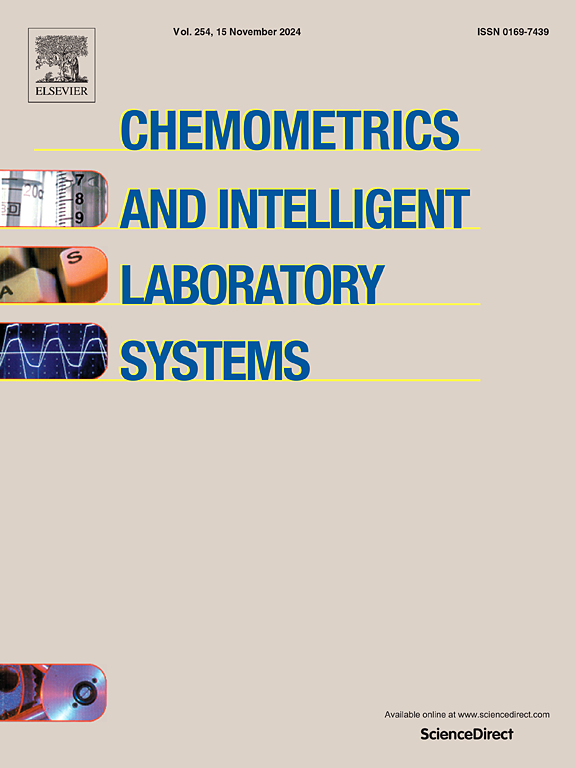通过拉曼光谱和注意力增强的1D-CNN高精度皮革物种识别
IF 3.8
2区 化学
Q2 AUTOMATION & CONTROL SYSTEMS
Chemometrics and Intelligent Laboratory Systems
Pub Date : 2025-10-09
DOI:10.1016/j.chemolab.2025.105549
引用次数: 0
摘要
来自不同动物来源的皮革在性能和价值上都有显著差异。传统的皮革鉴定方法存在主观性、低效率和高成本的问题,促使人们需要快速、客观和具有成本效益的替代方法。为了实现皮革类型的快速、无损分类,我们的研究引入了拉曼光谱和一维卷积神经网络(1D-CNN)的新组合,并增强了自注意机制,以有效捕获皮革类型之间的细微光谱差异。共收集了牛、羊、猪、鳄鱼皮革的1066个拉曼光谱。光谱数据经过平滑、基线校正和归一化处理。每个皮革类随机抽取7个样本作为训练集,其余3个样本作为独立的验证集。通过添加高斯噪声和应用轻微的频谱移位来模拟现实世界的可变性,将训练集扩展到3810个样本,从而实现数据增强。本文提出的1D-CNN模型引入了自注意机制提取关键光谱特征,并与不引入注意机制的机器学习模型和1D-CNN模型进行了比较。实验结果表明,我们的方法优于现有的方法。加入自注意机制后,模型在交叉验证中保持了较高的准确率,在独立测试集上的平均分类准确率从92.11%提高到96.28%。结果表明,该方法在不同的数据划分方案下均能取得较好的泛化性能。这种高效、无损、可靠的方法不仅可以实现准确的皮革种类识别和奢侈品认证,而且还显示出更广泛的材料分类和质量控制应用前景。本文章由计算机程序翻译,如有差异,请以英文原文为准。
High-accuracy leather species identification via Raman spectroscopy and attention-enhanced 1D-CNN
Leather derived from different animal sources exhibits significant differences in both performance and value. Traditional leather identification methods suffer from subjectivity, inefficiency, and high costs, motivating the need for rapid, objective, and cost-effective alternatives. To achieve rapid and non-destructive classification of leather types, our study introduces a novel combination of Raman spectroscopy and a one-dimensional convolutional neural network (1D-CNN) enhanced with a self-attention mechanism to efficiently capture subtle spectral differences among leather types. A total of 1066 Raman spectra from cow, sheep, pig, and crocodile leathers were collected. Spectral data underwent smoothing, baseline correction, and normalization. Seven samples from each leather class were randomly assigned to the training set, while the remaining three samples per class were designated as an independent validation set. Data augmentation was performed by adding Gaussian noise and applying slight spectral shifts to simulate real-world variability, expanding the training set to 3,810 samples. The proposed 1D-CNN model incorporates a self-attention mechanism to extract key spectral features and is compared with machine learning models and 1D-CNN models that do not integrate attention mechanisms. Experimental results demonstrate that our method outperforms existing approaches. After incorporating the self-attention mechanism, the model maintained a high accuracy during cross-validation, while its average classification accuracy on the independent test set increased from 92.11 % to 96.28 %. This result demonstrates that the proposed approach achieves enhanced generalization performance under different data partitioning schemes. This efficient, non-destructive, and reliable method not only enables accurate leather species identification and luxury goods authentication, but also shows promise for broader material classification and quality control applications.
求助全文
通过发布文献求助,成功后即可免费获取论文全文。
去求助
来源期刊
CiteScore
7.50
自引率
7.70%
发文量
169
审稿时长
3.4 months
期刊介绍:
Chemometrics and Intelligent Laboratory Systems publishes original research papers, short communications, reviews, tutorials and Original Software Publications reporting on development of novel statistical, mathematical, or computer techniques in Chemistry and related disciplines.
Chemometrics is the chemical discipline that uses mathematical and statistical methods to design or select optimal procedures and experiments, and to provide maximum chemical information by analysing chemical data.
The journal deals with the following topics:
1) Development of new statistical, mathematical and chemometrical methods for Chemistry and related fields (Environmental Chemistry, Biochemistry, Toxicology, System Biology, -Omics, etc.)
2) Novel applications of chemometrics to all branches of Chemistry and related fields (typical domains of interest are: process data analysis, experimental design, data mining, signal processing, supervised modelling, decision making, robust statistics, mixture analysis, multivariate calibration etc.) Routine applications of established chemometrical techniques will not be considered.
3) Development of new software that provides novel tools or truly advances the use of chemometrical methods.
4) Well characterized data sets to test performance for the new methods and software.
The journal complies with International Committee of Medical Journal Editors'' Uniform requirements for manuscripts.

 求助内容:
求助内容: 应助结果提醒方式:
应助结果提醒方式:


